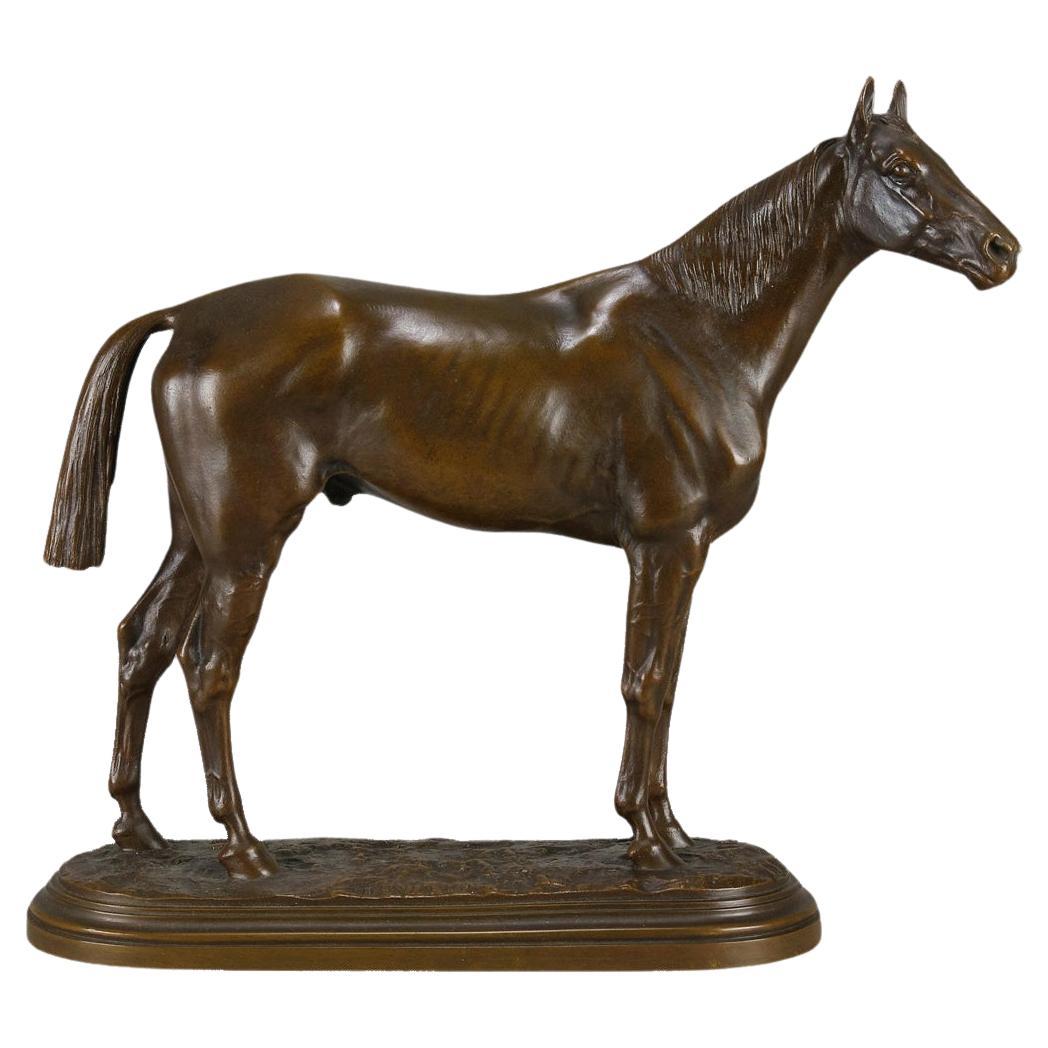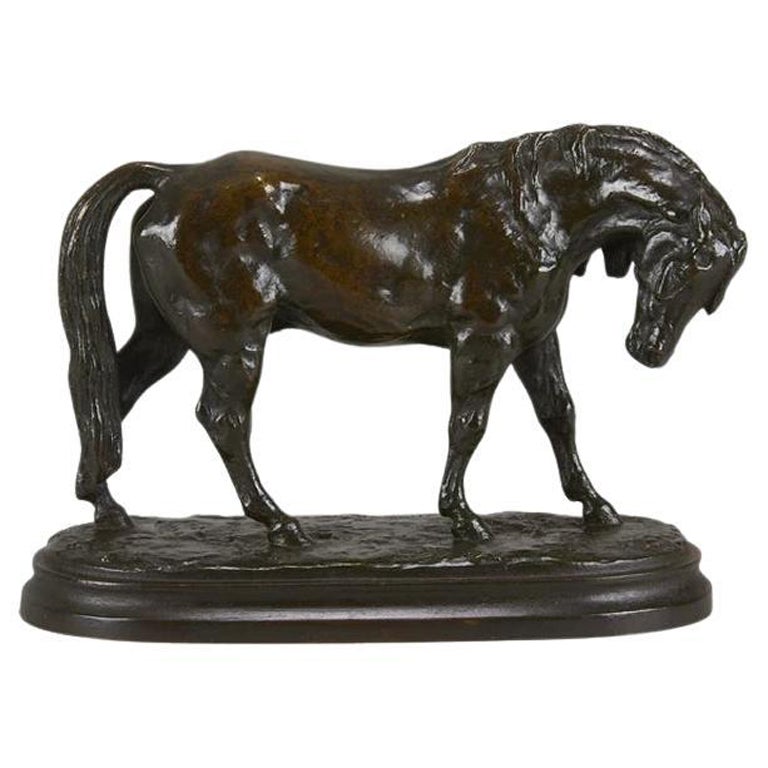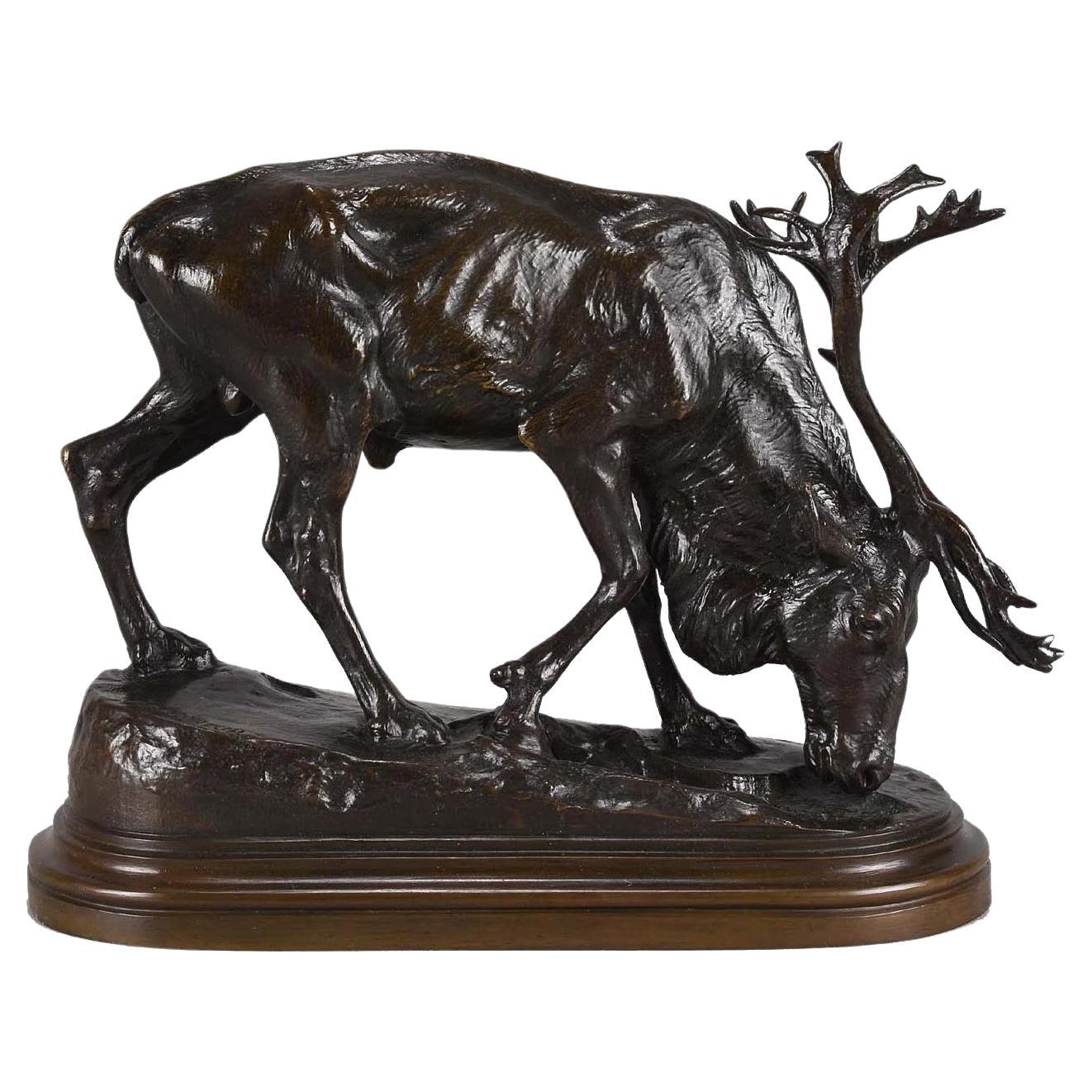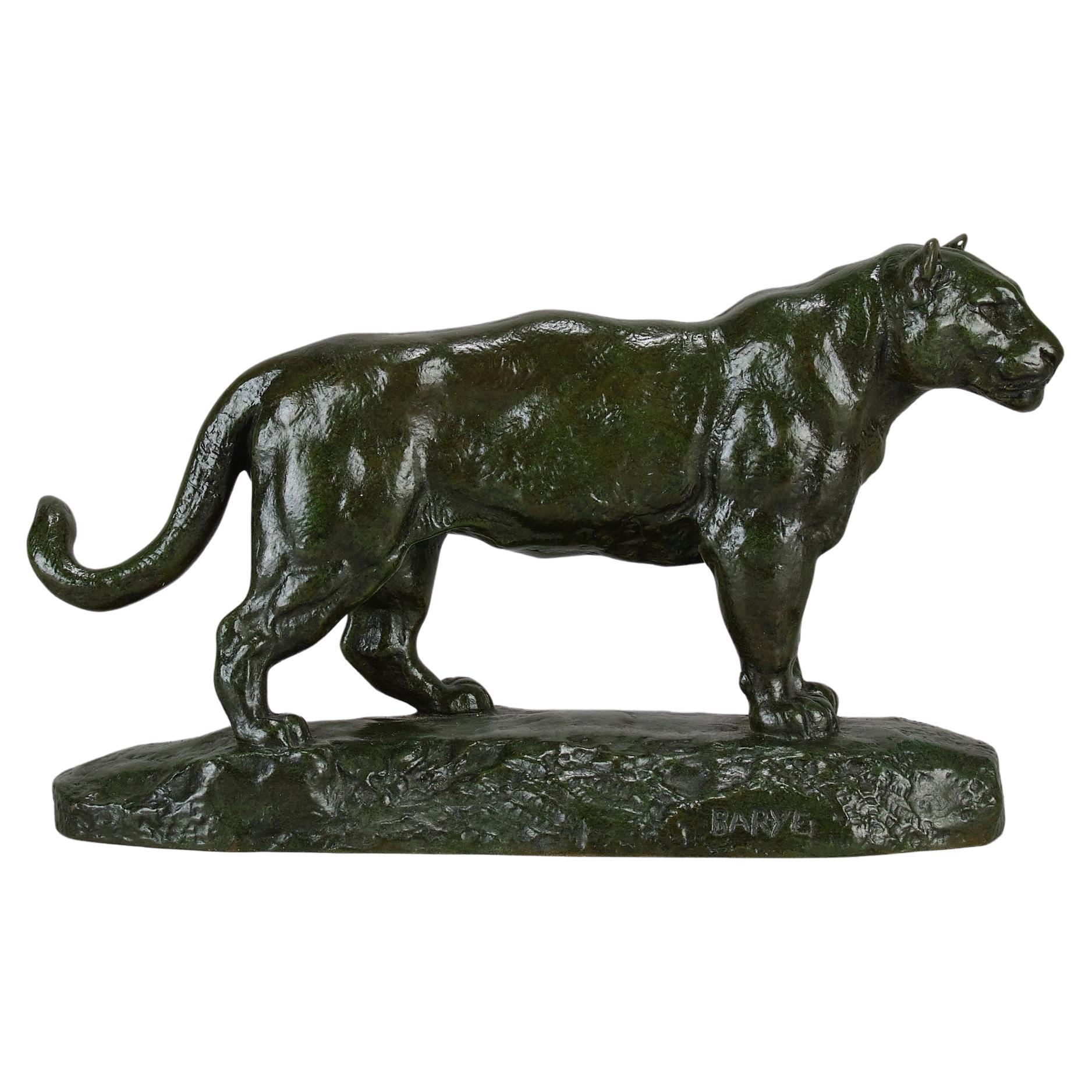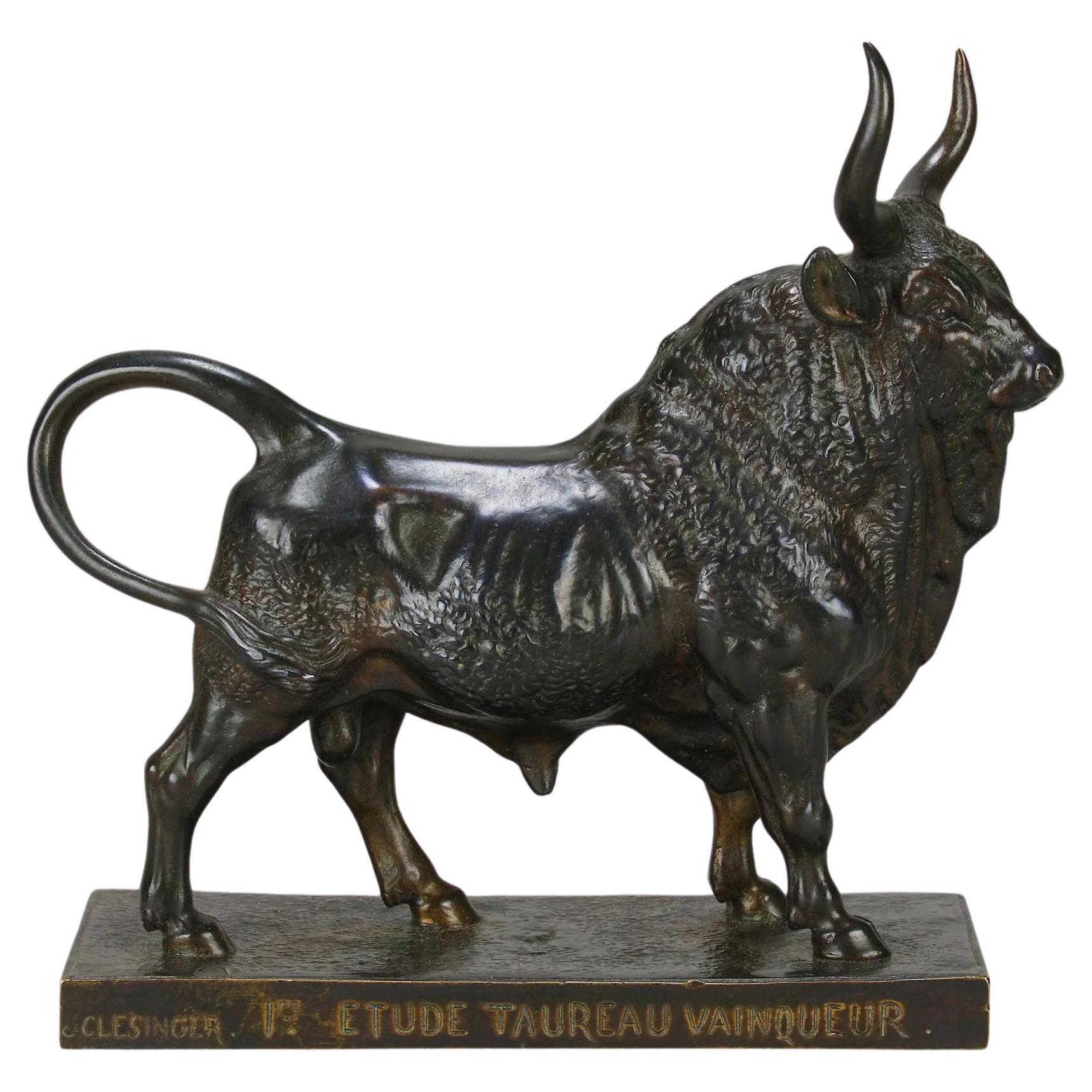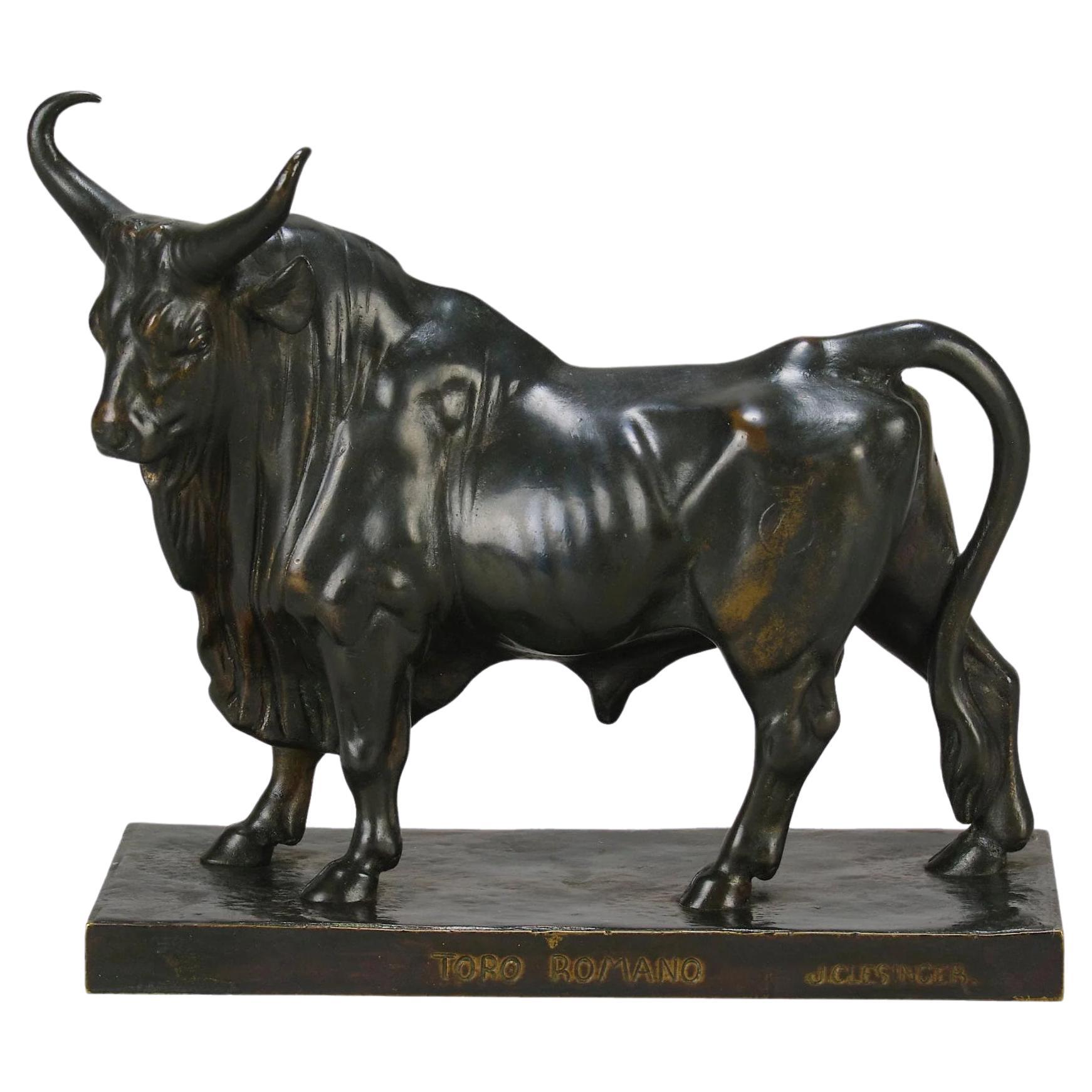Items Similar to 19th Century Animalier French Bronze Entitled "Taureau Debout" by Rosa Bonheur
Want more images or videos?
Request additional images or videos from the seller
1 of 12
19th Century Animalier French Bronze Entitled "Taureau Debout" by Rosa Bonheur
About the Item
"Taureau Debout" by Rosa Bonheur.
An excellent late 19th Century French animalier bronze study of a standing bull with fine hand chased surface that accentuates the muscle definition of the subject, signed Rosa B.
ADDITIONAL INFORMATION
Measures: Width: 32 cm
Height: 18 cm
Depth: 11cm
Condition: Excellent Original Condition
Circa: 1870
Materials: Bronze
Book reference: Animals in Bronze by Christopher Payne
Page no. 174
DESCRIPTION
Bonheur, Rosa (1822-1899)
The most popular artist of nineteenth-century France, Rosa Bonheur was also one of the first renowned painters of animals and the first woman awarded the Grand Cross by the French Legion of Honor. A professional artist with a successful career, Bonheur lived in two consecutive committed relationships with women.
Born on March 16, 1822 in Bordeaux, Marie Rosalie Bonheur was the oldest of the four children of Raimond Oscar Bonheur (1796-1849) and Sophie Marquis. Bonheur's father was an art teacher who came from a poor family, while her mother, a musician, had descended from a middle-class family and had been her husband's art student.
Bonheur's father, who taught drawing and landscape painting, was an ardent member of the utopian Saint Simeon society.
The group held idealistic beliefs about the reform of work, property, marriage, and the role of women in society. Most importantly, for the artist's future, the Saint Simeons questioned traditional gender norms and firmly believed in the equality of women. While teaching artistic techniques to his oldest daughter, Raimond Bonheur also encouraged her independence and taught her to consider art as a career.
In 1828 Raimond Bonheur joined the Saint Simeons at their retreat outside Paris. Sophie and the children joined him in Paris the following year. Four years later, however, Raimond abandoned his family to live in isolation with his fellow Saint Simeons.
Sophie Bonheur died in 1833 at the age of thirty-six. Rosa was only eleven years old when her mother died, but she was aware of the heavy price her mother paid for married life with a man who was more dedicated to his own ideals than to meeting his family's needs. Rosa also saw that her mother's marriage led to poverty and her death from exhaustion.
After her mother's death, Bonheur was taken in by the Micas family who resided nearby. Mme Micas and Bonheur's mother had been friends. When Mme Bonheur died, the Micas family paid Raimond Bonheur's debts and cared for Rosa. Their daughther, Nathalie, who would later become an amateur inventor and unschooled veterinarian, and Rosa became enamored with each other.
When Rosa Bonheur began her career as a professional artist, she had already been trained by her father who had allowed her to study in all male classes. Rosa also learned by sketching masterworks at the Louvre from the age of fourteen, and later, by studying with Léon Cogniet.
From the very beginning, Bonheur's favorite subject was animals. She learned their anatomy completely by dissecting them in local slaughterhouses. She also visited the horse market two times a week. Study of animals by direct observation led to the formation of the realist style in which Bonheur worked.
It was for such work that Bonheur obtained written permission from the French government to wear men's slacks. Her working attire also consisted of a loose smock and heavy boots that protected her feet from the dangerous environment in which she painted. The style of dress that the artist adopted for work and home may well have been influenced by her father's attire, which was based on St. Simeonian clothing experiments. Bonheur also cropped her hair, perhaps to facilitate her work. She did, however, always wear dresses for social occasions because she knew that appropriate dress would further her career.
Bonheur earned a successful living as a painter of animals. She exhibited at the annual Paris Salon regularly from the age of nineteen in 1841 through 1853, when she was thirty-one. She won the salon's gold medal at the age of twenty-six in 1848 and was commissioned by the French government to paint Plowing on the Nivernais in 1849. In the same year Bonheur and her sister Juliette became directors of l'École gratuite de dessin pour les jeunes filles, a post their father had once held.
Bonheur completed her most renowned work, The Horse Fair, in 1855. The successful representation of percherons (a breed native to Normandy) was purchased by Ernest Gambart, a London art dealer whose gallery specialized in work by French artists. He exhibited The Horse Fair in London where Bonheur visited with Nathalie. Queen Victoria requested a private viewing of the painting at Windsor Castle. It would later be purchased in 1887 by Cornelius Vanderbilt and donated to the new Metropolitan Museum of Art in New York City.
Bonheur's trip to England allowed her to meet Charles Eastlake, then President of the Royal Academy, John Ruskin, the English writer and critic, and Edwin Landseer, the British animalier. She also toured the English and Scottish countrysides and executed some paintings based on her observations of new breeds of animals found there.
Gambart made engravings of Bonheur's work, including The Horse Fair, and sold them in England, Europe, and the United States. Bonheur became one of the most renowned painters of the time. Little girls, such as Anna Klumpke in the United States, even had dolls in her likeness, much as American girls played with Shirley Temple dolls during the 1940s and 1950s.
In 1855, the same year in which Bonheur completed The Horse Fair, she also finished Haymaking at Auvergne. It was shown in the Paris Exposition Universelle that year and hung as a pendant to Plowing on the Nivernais and won the gold medal.
The monetary success Bonheur achieved allowed her to purchase Château By, a house and farm, near the Fontainebleu Forest in 1860. She retired there with Nathalie and Mme Micas during the same year. The three women divided the labor so that Mme Micas was the housekeeper, Nathalie prepared Bonheur's canvases and negotiated with art dealers, and Bonheur was the professional artist who provided income for the household.
During the years that Bonheur lived at By, she painted steadily and entertained celebrities. In 1865 she received a visit from Empress Eugénie who awarded the artist the Grand Cross of the Legion of Honor. Bonheur was the first woman to be singled out for the distinguished award established by Napoleon to recognize the achievements of French citizens.
During the last decade of Bonheur's life, she continued to paint. The most famous work of this period is the portrait she painted of Col. William F. Cody astride his horse. Bonheur had seen his Wild West show at the Paris Exposition of 1889 and at that time made sketches for his portrait. The sketches became the basis for her painting entitled The Buffalo Hunt (1889) and the image became the center of Cody's publicity campaign.
Great sadness enveloped Bonheur's life when Nathalie died during the same year. Her partner's ashes were buried along with those of her mother in the tomb Bonheur had purchased on the death of Mme Micas in 1875. Bonheur's grief overtook her to such a degree that it was very difficult for her to work or see friends. When the young artist Anna Klumpke first met her in 1895, Bonheur was not able to visit with her.
By 1893, however, Bonheur had recovered sufficiently to visit the United States to see the Women's Building at the World's Columbian Exposition in Chicago. When she returned to France, she was better able to talk with Anna Klumpke, the portrait painter from Boston, who had earned recognition for her work in France.
When the two women renewed acquaintance at By in 1895, Bonheur was 77 and Klumpke was 43. Over a brief time, the two women became captivated with each other and Bonheur offered Klumpke a living arrangement that they both signed on August 11, 1898. Bonheur agreed to build a studio for Klumpke at By and Klumpke agreed to paint portraits of Bonheur and to write the older artist's biography. Klumpke completed three portraits before the Bonheur's death on May 25, 1899.
Bonheur, as she had planned, was interred in the tomb she had purchased at Père Lachaise cemetery in Paris. The artist's career was celebrated with a retrospective exhibition at Galerie Georges Petit during 1900.
Although opposed by both her family and Bonheur's, Anna Klumpke managed Bonheur's estate the rest of her life. Klumpke painted a final portrait of Bonheur in 1902 and published Rosa Bonheur, sa vie et son oeuvre in 1908. In 1924, Klumpke dedicated the Musée Rosa Bonheur at By and established the Rosa Bonheur Memorial Art School to offer instruction to women. Two decades later, in 1940, Klumpke published Memoirs of an Artist. She died in 1942 and her ashes were entombed alongside Bonheur's in Père Lachaise cemetery three years later.
During the nineteenth century art was considered a lady's pastime to be pursued at home, but thanks to her father's influence, Bonheur understood her calling as a profession and made her livelihood from it. While Bonheur never referred to herself as a lesbian, she certainly understood her relationships with Nathalie Micas and Anna Klumpke to be a subversive form of matrimony. These liaisons rejected the patriarchal institution of marriage in favor of a matriarchal life in partnership. Bonheur used her last will and testament to force legal recognition of her right to transfer her property to another woman.
Despite Bonheur's popularity, her work was not universally acclaimed by contemporary critics. This was, no doubt, due, at least in part, to her lifestyle and her feminism. Quite apart from the considerable quality of her work, Bonheur remains important as an extraordinarily successful artist who rejected the patriarchal model of life and lived with the women she loved.
- Creator:Rosa Bonheur (Artist)
- Dimensions:Height: 7.09 in (18 cm)Width: 13 in (33 cm)Depth: 4.34 in (11 cm)
- Style:Art Nouveau (Of the Period)
- Materials and Techniques:Bronze,Cast
- Place of Origin:
- Period:
- Date of Manufacture:1870
- Condition:Wear consistent with age and use.
- Seller Location:London, GB
- Reference Number:
About the Seller
5.0
Gold Seller
These expertly vetted sellers are highly rated and consistently exceed customer expectations.
Established in 1936
1stDibs seller since 2017
63 sales on 1stDibs
Typical response time: <1 hour
- ShippingRetrieving quote...Ships From: London, United Kingdom
- Return PolicyA return for this item may be initiated within 10 days of delivery.
More From This SellerView All
- Late 19th Century Animalier Bronze entitled "Cheval Debout" by Isidore BonheurBy Isidore Jules BonheurLocated in London, GBMagnificent late 19th Century French Animalier bronze study of a standing thoroughbred with rich brown patina and excellent crisp surface detail, raised on a stepped integral base, s...Category
Antique Late 19th Century French Art Nouveau Animal Sculptures
MaterialsBronze
- French Animalier Bronze Study Entitled 'Cheval Debout' by Isidore BonheurBy Isidore Jules BonheurLocated in London, GBFabulous late 19th Century French Animalier bronze study of a standing horse with wonderful rich dark brown lightly rubbed to mid/golden brown patina and excellent crisp surface detail, raised on a stepped integral base, signed I Bonheur ADDITIONAL INFORMATION Height: 13 cm Length: 19 cm Condition: Excellent Original Condition Circa: 1870 Materials: Bronze Book Ref Animals in Bronze by Christopher Payne Kjellberg Page no. 177 SKU: 8526 DESCRIPTION Isidore Bonheur Bonheur Cheval– Isidore Bonheur (1827 ~ 1901) was born on May 15th 1827 in Bordeaux, France, and died in Paris in 1901. He was an important Animalier sculptor, the brother of Rosa Bonheur, and brother-in-law to Hippolyte Peyrol the founder. The Bonheurs were a well known family of painters, sculptors and artists. Isidore studied painting under the tutelage of his father at a very early age. He moved on to sculpture in 1848 with his first Salon entry of a plaster study of An African Horseman attacked by a lion. Isidore Bonheur continued exhibiting his sculpture throughout the years, both at the Salon in Paris as well as the Royal Academy in London. He won medals at the Salon in 1865 and 1869, and won the Gold Medal at the Paris Exposition Universelle of 1889. Bonheur was awarded the Legion of Honneur in 1895. Isidore Bonheur’s bronzes range from domestic cattle and sheep, which he excelled at, to wild bears and lions as well as equestrian and hunting groups, all done in a very natural and realistic manner. His Le Grand Jockey...Category
Antique Late 19th Century French Victorian Animal Sculptures
MaterialsBronze
- 19th Century Animalier Bronze Sculpture Entitled "Reindeer" by Isidore BonheurBy Isidore Jules BonheurLocated in London, GBExcellent late 19th century animalier bronze study of a feeding reindeer with rich brown colour and very fine hand chased and etched surface detail, raised on a stepped naturalistic base, stamped with Peyrol Foundry mark and signed Isidore Bonheur Additional information Height: 16 cm Width: 22 cm Condition: Excellent Original Condition Foundry: Peyrol circa: 1880 Materials: Bronze SKU: 8211 DESCRIPTION Isidore Bonheur Isidore Bonheur, born in Bordeaux May 15 1827. Isidore was the third child of Christine Dorotheé Sophie Marquis (1797–1833), a musician, and Oscar-Raymond Bonheur (1796–1849) (a landscape and portrait painter and an early adherent of Saint-Simonianism, a Christian-socialist sect that promoted the education of women alongside men). Isidore was the brother of Auguste Bonheur...Category
Antique Late 19th Century French Art Nouveau Animal Sculptures
MaterialsBronze
- 19th Century Animalier Bronze Study entitled "Jaguar Debout" by Antoine L BaryeBy Antoine-Louis BaryeLocated in London, GBAn impressive late 19th Century Animalier bronze study of a standing panther with excellent rich green patina and very fine hand chased surface detail. Raised on an integral base, si...Category
Antique Late 19th Century French Art Nouveau Animal Sculptures
MaterialsBronze
- 19th Century Animalier Bronze "Taureau Vainqueur" by Jean-Baptiste ClesingerBy Jean-Baptiste ClésingerLocated in London, GBAn impressive late 19th century French bronze study of a majestic bull with standing in a proud stance exhibiting excellent hand chased surface detail and fine rich brown patina. Rai...Category
Antique Mid-19th Century French Art Nouveau Animal Sculptures
MaterialsBronze
- 19th Century Animalier Bronze "Taureau Romano" by Jean-Baptiste ClesingerBy Jean-Baptiste ClésingerLocated in London, GBA magnificent late 19th century French bronze study of a large bull in a proud stance, the bronze exhibiting excellent hand chased surface detail and fine rich brown patina. Raised o...Category
Antique 19th Century French Art Nouveau Animal Sculptures
MaterialsBronze
You May Also Like
- French Bronze Figure of a Bull, by Rosa BonheurLocated in New York, NYInscribed "Rosa B" and stamped with the "Peyrol" foundry on the base.Category
Antique 1860s Animal Sculptures
MaterialsBronze
- A 19th Century French Patinated Bronze Sculpture entitled, "Gloria Patria".Located in Los Angeles, CAA fine 19th Century French Patinated Bronze Sculpture - "Gloria Patria" (Homeland Glory) by Eugene Marioton. Titled on the front of the base: Gloria Patria Signed: Marioton Dimens...Category
Antique 19th Century French Napoleon III Sculptures
MaterialsBronze
- 19th Century French Bronze Sculpture entitled An accident by Charles AnfrieBy Vrai Bronze B.D., Charles AnfrieLocated in Lisbon, PTA Charles Anfrie (Catalan sculptor Charles Anfrie, 1833-1905) bronze statue of a boy “C. Anfrie” signed with “ Vrai Bronze Garanti. Paris. BL” caster seal and titled 'Un accident' ...Category
Antique 19th Century French Napoleon III Figurative Sculptures
MaterialsBronze
- French 19th Century Patinated Bronze Entitled ‘Chemin Des Roses’ by August MoreaBy Auguste MoreauLocated in West Palm Beach, FLA charming French 19th century patinated bronze entitled 'Chemin des Roses', Path Of the Roses, by August Moreau. The bronze is raised by a mottled circular Verde Antico marble base ...Category
Antique 19th Century French Figurative Sculptures
MaterialsMarble, Bronze
- Late 19th Century French Bronze Sculpture "Le Grand Jockey" Signed I. BonheurBy Isidore Jules BonheurLocated in Dallas, TXDecorate an office or study with this large antique bronze sculpture. Created in France circa 1880, and signed by French sculptor Isidore Bonheur, the sculpture is set on a green mar...Category
Antique Late 19th Century French Animal Sculptures
MaterialsMarble, Bronze
- French 19th Century Bronze Sculpture After Paul Dubois Entitled La CharitéLocated in New York, NYLa Charité Bronze Sculpture After Paul Dubois (1829-1905).Category
Antique Late 19th Century French Romantic Figurative Sculptures
MaterialsBronze
Recently Viewed
View AllMore Ways To Browse
French Marriage
Decorative Antique Fair
Castle Objects
Grand Cross
St George 19th
Sold Price Bronze
French Farm House
Antique Furniture Nearby
Rosa Antique
Dress Form Sculpture
Antique Mica
Bronze Decorative Cross
French Marquis
Dior 1950s Dress
Antique Little Girl
Cross Scotland
Scottish Cross
19th Century Male Bronzes
